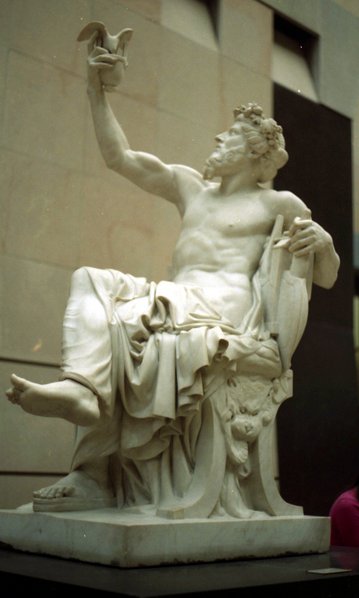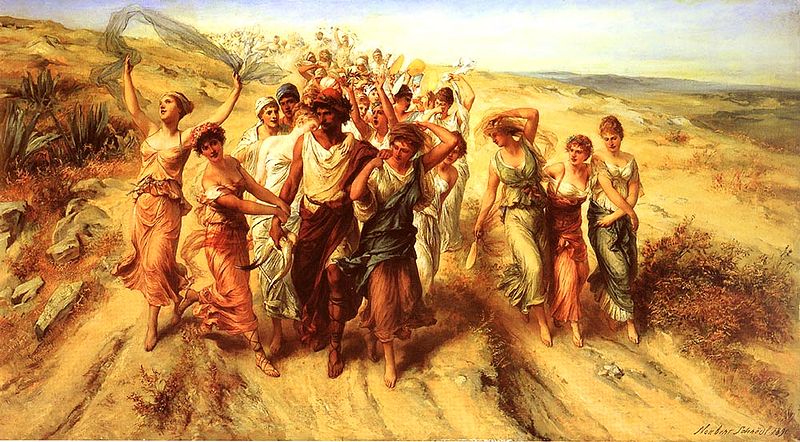<Back to Index>
- Lyric Poet Anacreon of Teos (Ανακρέων), 582 B.C.
PAGE SPONSOR
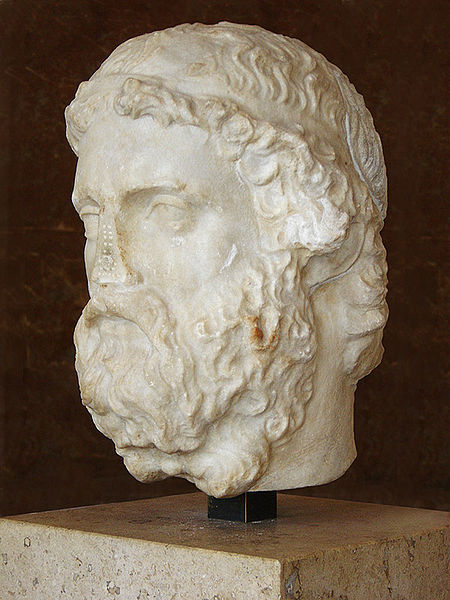
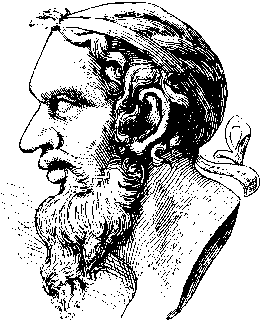
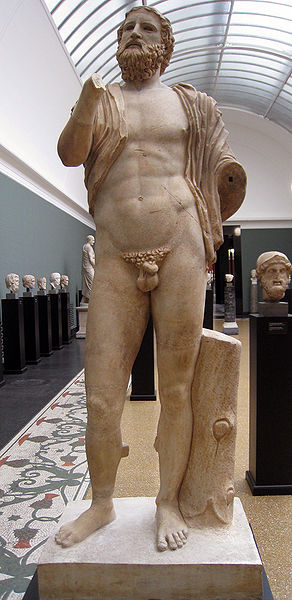
Anacreon (Greek Ἀνακρέων, gen.: Ἀνακρέοντος) (582 BC – 485 BC) was a Greek lyric poet, notable for his drinking songs and hymns. Later Greeks included him in the canonical list of nine lyric poets.
Anacreon was born at Teos, an Ionian city on the coast of Asia Minor. The name and identity of his father is a matter of dispute, with different authorities naming four possibilities: Scythianus, Eumelus, Parthenius, or Aristocritus.
It is likely that Anacreon fled into exile with the mass of his fellow townsmen who sailed to Thrace when their homeland was attacked. There they founded a colony at Abdera, rather than remaining behind to surrender their city to Harpagus, one of Cyrus the Great's generals. Cyrus was, at the time (545 BC), besieging the Greek cities of Asia Minor. Anacreon seems to have taken part in the fighting, in which, by his own admission, he did not distinguish himself.
From Thrace he removed to the court of Polycrates of Samos. He is said to have acted as tutor to Polycrates; that he enjoyed the tyrant's confidence we learn on the authority of Herodotus, who represents the poet as sitting in the royal chamber when audience was given to the Persian herald. In return for his favor and protection, Anacreon wrote many complimentary odes upon his patron. Like his fellow lyric poet, Horace, who was one of his great admirers, and in many respects a kindred spirit, Anacreon seems to have been made for the society of courts.
On the death of Polycrates, Hipparchus, who was then in power at Athens and inherited the literary tastes of his father Peisistratus, sent a special embassy to fetch the popular poet to Athens in a galley of fifty oars. Here he became acquainted with the poet Simonides, and other members of the brilliant circle which had gathered round Hipparchus. When this circle was broken up by the assassination of Hipparchus, Anacreon seems to have returned to his native town of Teos, where, according to a metrical epitaph ascribed to his friend Simonides, he died and was buried.
According to others, before returning to Teos, he accompanied Simonides to the court of Echecrates, a Thessalian dynast of the house of the Aleuadae. Lucian mentions Anacreon amongst his instances of the longevity of eminent men, as having completed eighty - five years. If an anecdote given by Pliny the Elder is to be trusted, he was choked at last by a grape stone, but the story has an air of mythical adaptation to the poet's habits, which makes it somewhat apocryphal.
Anacreon was for a long time popular at Athens, where his statue was to be seen on the Acropolis, together with that of his friend Xanthippus, the father of Pericles.
On several coins of Teos he is represented holding a lyre in his hand,
sometimes sitting, sometimes standing. A marble statue found in 1835 in
the Sabine district, and now in the Galleria Borghese, is said to represent Anacreon.
Anacreon wrote all of his poetry in the ancient Ionic dialect. Like all early lyric poetry, it was composed to be sung or recited to the accompaniment of music, usually the lyre. Anacreon's verses were primarily in the form of monody, which means that they were to be performed by a single voice rather than by a chorus.
In keeping with Greek poetic tradition, his poetry relied on meter for its construction. Metrical poetry is a particularly rhythmic form, deriving its structure from patterns of phonetic features within and between the lines of verse. The phonetic patterning in Anacreon's poetry, like all the Greek poetry of the day, is found in the structured alternation of "long" and "short" vowel sounds. The Ionic dialect also had a tonal aspect to it that lends a natural melodic quality to the recitation. Anacreon's meters include the anacreonteus.
The Greek language is particularly well suited to this metrical style
of poetry but the sound of the verses does not easily transfer to
English. As a consequence, translators have historically tended to
substitute rhyme, stress rhythms, stanzaic patterning and other devices
for the style of the originals, with the primary, sometimes only,
connection to the Greek verses being the subject matter. More recent
translators have tended to attempt a more spare translation which,
though losing the sound of the originals, may be more true to their
flavor. A sample of a translation in the English rhyming tradition is
included below.
Anacreon's poetry touched on universal themes of love, infatuation, disappointment, revelry, parties, festivals, and the observations of everyday people and life. It is the subject matter of Anacreon's poetry that helped to keep it familiar and enjoyable to generations of readers and listeners. His widespread popularity inspired countless imitators, which also kept his name alive.
Anacreon had a reputation as a composer of hymns, as well as of those bacchanalian and amatory lyrics which are commonly associated with his name. Two short hymns to Artemis and Dionysus, consisting of eight and eleven lines respectively, stand first amongst his few undisputed remains, as printed by recent editors. But hymns, especially when addressed to such deities as Aphrodite, Eros and Dionysus, are not so very unlike what we call "Anacreontic" poetry as to make the contrast of style as great as the word might seem to imply. The tone of Anacreon's lyric effusions has probably led to an unjust estimate, by both ancients and moderns, of the poet's personal character. The "triple worship" of the Muses, Wine and Love, ascribed to him as his religion in an old Greek epigram, may have been as purely professional in the two last cases as in the first, and his private character on such points was probably neither much better nor worse than that of his contemporaries. Athenaeus remarks acutely that he seems at least to have been sober when he wrote. His character was an issue, because, according to Pausanias, his statue on the Acropolis of Athens depicts him as drunk. He himself strongly repudiates, as Horace does, the brutal characteristics of intoxication as fit only for barbarians and Scythians.
Of the five books of lyrical pieces by Anacreon which the Suda and Athenaeus mention as extant in their time, we have now but the merest fragments, collected from the citations of later writers.
A collection of poems by numerous, anonymous imitators was long believed to be the works of Anacreon himself. Known as the Anacreontea, it was preserved in a 10th century manuscript which also included the Palatine Anthology. The poems were published in 1554 with a Latin translation by Henry Estienne, known as Stephanus, but little is known about the origins of the manuscript. Salmasius reports seeing the Anacreontea at the library in Heidelberg in 1607. In 1623, it was given to Pope Gregory XV after the sacking of Heidelberg. It was later taken from the Vatican City by Napoleon in 1797, who had it rebound as two separate volumes. One of those volumes was returned to Heidelberg but the other remained in the Bibliothèque Nationale in Paris.
In the 17th century, Thomas Stanley translated the Anacreontea into English verse. A few poems were also translated by Robert Herrick and Abraham Cowley.
The poems themselves appear to have been composed over a long period of
time, from the time of Alexander the Great until the time that paganism
gave way in the Roman Empire. They reflect the light hearted elegance
of much of Anacreon's genuine works although they were not written in
the same Ionic Greek
dialect that Anacreon used. They also display literary references and
styles more common to the time of their actual composition.
Typical of most efforts at translation, this 19th century one by Walter Headlam (1866 – 1908) takes the subject matter of Anacreon's verses and works them into a rhyming style typical of the English poetry written in Headlam's day. The subject of the poem still remains: Anacreon complaining that a young woman, whom he compares to a Thracian filly, doesn't recognize his amatory skills.
Ah tell me why you turn and fly,
My little Thracian filly shy?
Why turn askance
That cruel glance,
And think that such a dunce am I?
O I am blest with ample wit
To fix the bridle and the bit,
And make thee bend
Each turning-end
In harness all the course of it.
But now 'tis yet the meadow free
And frisking it with merry glee;
The master yet
Has not been met
To mount the car and manage thee.
Literature
- Anakreons Grab (Anacreon's Grave) is a poem by Goethe
- Leconte de Lisle wrote a series of "Odes anacréontiques", one of which, "La rose", was set to music in a mélodie for soprano and piano by Gabriel Fauré.
- Edgar Allan Poe wrote in his poem, "Romance," that he had been "an idle boy ... Who read Anacreon, and drank wine."
- Anacreon is one of four barbaric worlds surrounding Terminus, the center of the Encyclopedia Galactica in Isaac Asimov's Foundation series.
- Anacreon appears as a character in Mary Renault's historical novel The Praise Singer (1978).
Music
- Anacreon is the subject of two separate operas by the French composer Jean - Philippe Rameau, both called Anacréon (the first premiered in 1754, the second in 1757), as well as the opera - ballet Anacréon ou l'amour fugitif (1803) by Luigi Cherubini.
- Anacreon's poems were very popular in the 18th century, and thus Lorenzo da Ponte wrote the verses to Leporello's Aria in Don Giovanni following a poem of Anacreon (Poem XXXII).
- "To Anacreon in Heaven" is the opening line (and often mistaken for the title of) of "The Anacreontic Song", the official song of the London amateur musical club the Anacreontic Society. The US national anthem, "The Star Spangled Banner", is set to the tune of "The Anacreontic Song".
- Hugo Wolf used Goethe's poem for his lied Anakreons Grab (written 1888, published 1890, orchestrated version 1893).
